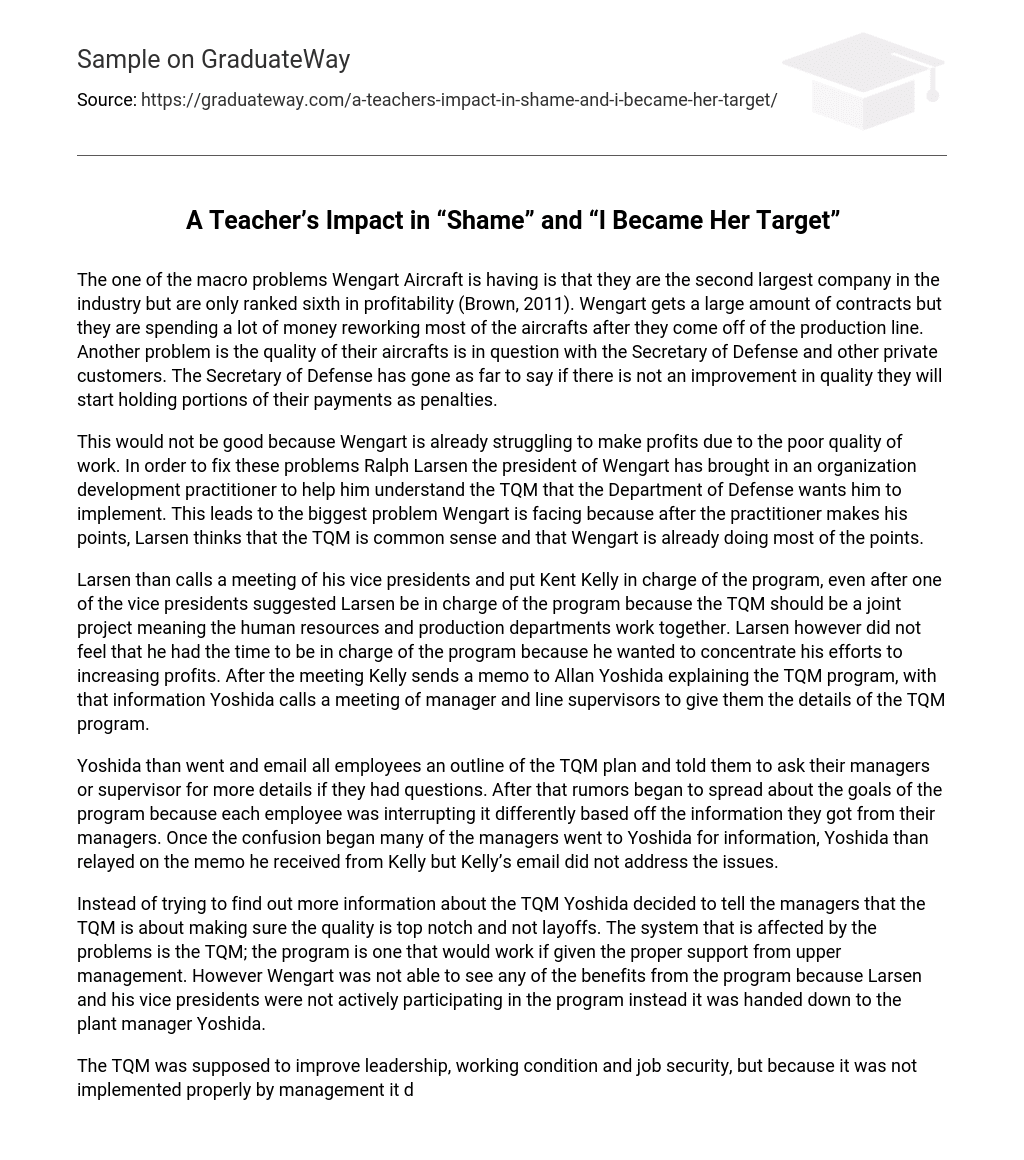Wengart Aircraft is facing several challenges. Despite being the second largest company in the industry, their profitability ranking is only sixth (Brown, 2011). A significant issue is the high expenditure on reworking the aircraft after production, even though they secure a large number of contracts. Moreover, the quality of their aircrafts is raising concerns among the Secretary of Defense and other private customers. The Secretary of Defense has even threatened to withhold portions of their payments as penalties if the quality does not improve.
This would not be advantageous as Wengart is already experiencing difficulties in generating profits as a result of subpar work quality. To address these issues, Ralph Larsen, the president of Wengart, has enlisted the assistance of an organization development practitioner to assist him in comprehending the Total Quality Management (TQM) that the Department of Defense expects him to implement. This presents a major challenge for Wengart because upon hearing the practitioner’s insights, Larsen believes that TQM is simply common sense and that Wengart is already implementing most of its principles.
Despite a vice president’s suggestion that Larsen should be in charge of the program to ensure the cooperation between the human resources and production departments, Larsen instead appoints Kent Kelly to lead the program. Larsen believes he doesn’t have the time to oversee it because he is focused on increasing profits. Subsequently, Kelly sends a memo to Allan Yoshida outlining the details of the TQM program. Using this information, Yoshida convenes a meeting with managers and line supervisors to provide them with the specifics of the TQM program.
Yoshida sent an email to all employees containing an outline of the TQM plan. He instructed them to approach their managers or supervisors for further clarification if they had any questions. However, this resulted in various interpretations of the program’s goals among employees, as each received information from their respective managers. As confusion spread, many managers approached Yoshida seeking clarification. Yoshida then relied on the memo received from Kelly, but unfortunately, Kelly’s email did not address the concerns raised.
Rather than seeking further information about TQM, Yoshida opted to inform the managers that TQM is primarily concerned with ensuring excellent quality and not layoffs. The system affected by the issues discussed is TQM. It is a program that could be successful with proper support from upper management. Unfortunately, Larsen and his vice presidents did not actively engage in the program, leaving Yoshida, the plant manager, to handle it without receiving any of its benefits.
The TQM program aimed to enhance leadership, working conditions, and job security. However, due to inadequate implementation by management, it had the opposite effect. Employees became apprehensive about potential layoffs and lost trust in their managers as they felt important information was being withheld from them. Possible alternatives could have entailed Yoshida sharing all available details about the TQM program with everyone or organizing a meeting with Kelly to address the concerns raised by the production manager and supervisors.
The ideal recommendation would have been for Larsen to lead the TQM program, as it could potentially enhance the company’s profits if executed correctly. The practitioner highlighted two key points: Larsen and his vice presidents needed to embrace work principles such as better leadership, improved working conditions, and job security. Additionally, Larsen and his top management had to show a strong commitment to TQM and consistently demonstrate it through their words and actions (Brown, 2011). Unfortunately, this did not occur from the outset, as Larsen delegated the program’s responsibility to Kelly.
Larsen should have included his upper management in the meeting with the practitioner, as they needed a clearer understanding of the program to effectively explain it to the managers and supervisors on the production line. The main issue stemmed from a lack of communication and commitment from Wengart’s upper management. If the TQM program had been presented to all managers, they would have had a uniform understanding, eliminating the need for individual interpretations when educating their subordinates.
By providing employees with only a basic outline of the TQM program, both the employees and managers at Wengart questioned its intentions and resulted in numerous miscommunications. If the communication had been clearer at Wengart, the employees would have had a better understanding of the TQM program and it would have been more effective, as the practitioner had assured Larsen. (Word Count: 853) References: Brown, D. R. (2011). An experiential approach to organization development (8th ed.). Boston: Prentice Hall.





